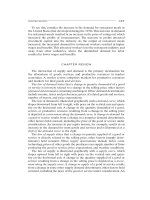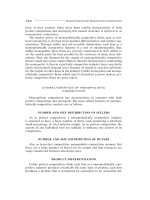Brand management research theory and practice
Bạn đang xem bản rút gọn của tài liệu. Xem và tải ngay bản đầy đủ của tài liệu tại đây (1.97 MB, 286 trang )
Brand Management
“Without question, branding is a complex management area that deserves study from a
variety of different perspectives and academic traditions. By providing a multi-disciplinary
approach, this textbook provides a welcome and invaluable resource for thoughtful students,
scholars, and practitioners who want to fully understand branding and brand management.”
Kevin Lane Keller, Tuck School of Business at Dartmouth
“At last a book that cuts through the clutter about understanding brand and so clearly clarifies the brand concept. A book that superbly bridges the academic domain and enables
practitioners use it to build brand equity.”
Leslie de Chernatony, Birmingham University Business School
“We think this is an excellent treatment of our topic. Thorough and complete, yet concise
and very readable. We love the design and structure, both with regards to the seven
approaches, as well as to the four layers within each approach.”
Albert M. Muniz, Jr., DePaul University and Thomas C. O’Guinn, University of Wisconsin
For over two decades it has been argued that the brand is an important value creator and
should therefore be a top management priority. However, the definition of what a brand is
remains elusive.
This comprehensive book presents the reader with an exhaustive analysis of the scientific and paradigmatic approaches to the nature of brand as it has developed over the last
twenty years. Taking a multidisciplinary approach and offering an exhaustive analysis of
brand research literature, it delivers a thorough understanding of the managerial implications of these different approaches to the management of the brand.
Brand Management: Research, theory and practice fills a gap in the market, providing
an understanding of how the nature of brand and the idea of the consumer differ in these
approaches, and offers in-depth insight into the opening question of almost every brand
management course: ‘What is a brand?’
Tilde Heding and Charlotte F. Knudtzen both lecture in strategic brand management at
Copenhagen Business School. Tilde and Charlotte have published widely, while also
running their own brand management consultancy, Heding & Knudtzen. Mogens Bjerre is
associate professor of Marketing at Copenhagen Business School. He has published extensively in the fields of franchising, key accounts management, strategic relationship
marketing and retailing.
Brand Management
Research, theory and practice
Tilde Heding, Charlotte F. Knudtzen
and Mogens Bjerre
First published 2009 by Routledge
2 Park Square, Milton Park, Abingdon, Oxon OX14 4RN
Simultaneously published in the USA and Canada
by Routledge
270 Madison Ave, New York, NY 10016
Routledge is an imprint of the Taylor & Francis Group, an informa business
This edition published in the Taylor & Francis e-Library, 2008.
“To purchase your own copy of this or any of Taylor & Francis or Routledge’s
collection of thousands of eBooks please go to www.eBookstore.tandf.co.uk.”
© 2009 Tilde Heding, Charlotte F. Knudtzen and Mogens Bjerre
Typeset in Times New Roman by Saxon Graphics Ltd, Derby
Printed and bound in Great Britain by MPG Books, Bodmin
All rights reserved. No part of this book may be reprinted or reproduced or
utilised in any form or by any electronic, mechanical, or other means, now
known or hereafter invented, including photocopying and recording, or in
any information storage or retrieval system, without permission in writing
from the publishers.
British Library Cataloguing in Publication Data
A catalogue record for this book is available from the British Library
Library of Congress Cataloguing in Publication Data
Library of Congress Cataloging-in-Publication Data
Heding, Tilde.
Brand management : research, theory and practice / Tilde Heding,
Charlotte F. Knudtzen and Mogens Bjerre.
p. cm.
ISBN 978–0–415–44326–5 (hbk.) – ISBN 978–0–415–44327–2 (pbk.) –
ISBN 978–0–203–99617–1 (ebook) 1. Brand name products–Management.
2. Branding (Marketing) I. Knudtzen, Charlotte F. II. Bjerre, Mogens,
1959- III. Title.
HD69.B7H43 2008
658.8Ј27–dc22
2008021896
ISBN 0-203-99617-8 Master e-book ISBN
ISBN10: 0–415–44326–1 (hbk)
ISBN10: 0–415–44327-X (pbk)
ISBN10: 0–203–99617–8 (ebk)
ISBN13: 978–0–415–44326–5 (hbk)
ISBN13: 978–0–415–44327–2 (pbk)
ISBN13: 978–0–203–99617–1 (ebk)
Contents
List of illustrations
List of tables
List of boxes
Foreword Leslie de Chernatony
Preface
Acknowledgements
vii
x
xi
xiii
xv
xvii
PART I
Setting the scene
1
1
Introduction
3
2
Key words in brand management
9
3
Overview: brand management 1985–2006
20
PART II
Seven brand approaches
27
4
The economic approach
29
5
The identity approach
47
6
The consumer-based approach
83
7
The personality approach
116
8
The relational approach
151
9
The community approach
181
10 The cultural approach
207
vi Contents
PART III
Taxonomy
243
11 Taxonomy of brand management 1985–2006
245
Index
260
List of illustrations
1.1
1.2
4.1
4.2
4.3
4.4
4.5
4.6
4.7
5.1
5.2
5.3
5.4
5.5
5.6
5.7
5.8
5.9
5.10
6.1
6.2
6.3
6.4
6.5
6.6
6.7
6.8
6.9
The logic of the approach chapters
A readers’ guide
The brand–consumer exchange of the economic approach
Assumptions of the economic approach
Supporting themes of the economic approach
Core theme and supporting themes of the economic approach
Theoretical building blocks of the economic approach
Relation between price and demand
Methods and data of the economic approach
Sources of brand identity
Assumptions of the identity approach
Supporting themes of the identity approach
Brand identity: the core theme and alignment frameworks
of the identity approach
Alignment of the strategic stars of brand identity
Theory of the identity approach
Manifestations of organizational identity (culture)
Methods and data of the identity approach
Drivers of the alignment process of brand identity
Managerial implications of the identity approach
The brand resides in the mind of the consumer
The computer is the central metaphor of man in cognitive
psychology
Assumptions of the consumer-based approach
Supporting themes and the core themes of the consumer-based
approach
Simple associative network spreading from the node
Volkswagen
The three forms of cognition applied to brands
Dimensions of brand knowledge
Associations spreading from the node ‘Seven up’
‘Seven up’ brand associations adapted to the customer-based
brand equity framework
5
6
31
34
35
39
40
42
43
50
55
56
60
62
64
67
70
71
77
85
86
87
88
89
90
93
96
97
viii List of illustrations
6.10
6.11
6.12
6.13
7.1
7.2
7.3
7.4
7.5
7.6
7.7
7.8
7.9
7.10
7.11
7.12
7.13
8.1
8.2
8.3
8.4
8.5
8.6
8.7
9.1
9.2
9.3
9.4
9.5
9.6
9.7
9.8
9.9
9.10
10.1
10.2
10.3
10.4
10.5
10.6
Theory of the consumer-based approach
Methods and data of the consumer-based approach
Dualistic mechanisms of the consumer-based approach
influencing the managerial implications
Managerial implications of the consumer-based approach
Brand personality construct
Assumptions of the personality approach
Supporting themes of the personality approach
Brand behaviour
Consumer self construct
The brand–self exchange of symbolic brand value in the
market place
Core theme of the personality approach: brand personality
Dimensions of brand personality
Theory of the personality approach
Methods and data of the personality approach
Brand personality dimensions, traits and brand behaviour
Brand–self congruence of Chanel No. 5
Managerial implications of the personality approach
‘Dyadic’ brand–consumer relationship
Assumptions of the relational approach
Supporting themes and core theme of the relational approach
Preliminary model of brand relationship quality and its effects
on relationship stability
Theoretical building blocks of the relational approach
Methods and data of the relational approach
Managerial implications of the relational approach
The ‘brand triad’
Assumptions of the community approach
Supporting themes of brand community
Conceptualization of the community in the sociological
tradition
Brand community construct
Theoretical building blocks of the community approach
Methods and data of the community approach
The marketer as observer of a brand community
The marketer as facilitator of a brand community
Managerial implications of the community approach
Scope of the cultural approach
Assumptions of the cultural approach
The core theme, its supporting theme, the societal comment
on brand icons and the future brand scenario
The movement of meaning
Iconic brands are brands that have become cultural icons
Theoretical building blocks of the cultural approach
98
103
104
109
119
121
122
123
125
128
129
130
133
138
142
144
147
154
156
157
163
165
170
176
183
185
186
187
188
191
196
198
201
203
210
213
214
215
217
224
List of illustrations ix
10.7
10.8
10.9
10.10
11.1
11.2
11.3
Research methods of the cultural approach
Methods and data of the cultural approach
The cultural brand management process
Managerial implications of the cultural approach
Taxonomy of brand management 1985–2006
Two dimensions and four brand management paradigms
The logic of the approach chapters
227
228
229
235
246
252
257
List of tables
5.1
5.2
5.3
5.4
5.5
6.1
7.1
8.1
8.2
9.1
10.1
10.2
11.1
11.2
11.3
11.4
Product and corporate branding
The internal and external supporting themes adding up to
brand identity
Three perspectives on organizational culture
Detecting identity gaps
Aligning identity gaps
A simple version of a matrix array
Creating brand personality in accordance with the consumer
self construct
Relationship forms
Differences between the information-processing and the
experiential consumer perspective
Variations of brand community
A comparison between the mindshare branding model and the
cultural branding model
The postmodern and the post-postmodern branding paradigm
The roles of brands
Four brand management paradigms
A comparison of axioms across four branding models
Comparison of brand management categorizations
51
59
66
73
74
100
140
161
174
190
220
223
251
254
255
256
List of boxes
3.1
4.1
4.2
4.3
5.1
5.2
5.3
5.4
5.5
5.6
5.7
5.8
6.1
6.2
6.3
6.4
6.5
6.6
6.7
6.8
7.1
7.2
7.3
7.4
7.5
7.6
7.7
7.8
8.1
Overview of brand management 1985–2006
Economic man: individual and societal maximization in a
supermarket checkout queue
Transactional versus relational perspective on brand
management
Regression analysis
The identity concept adopted from marketing
From product to corporate branding at Lego
Is identity enduring?
Culture in the identity approach
Misaligned identities: the case of Body Shop
Doing a study of brand identity yourself
Living the brand: all about the people of Quiksilver
Do’s and don’ts of the identity approach
Memory representations
Heuristics are important in low-involvement categories
How to structure brand associations
Projective techniques
Map out customers’ brand associations yourself
Things to consider when choosing the right brand name
Six managerial guidelines
Do’s and don’ts of the consumer-based approach
Oil of Olay: female consumers’ hopes and dreams
Archetypes and brand personality
Ordinal scales applied
Interval scales applied
‘Six steps’ method of exploring and measuring brand
personality
Brand personalities in practice
When good brands do bad
Do’s and don’ts of the personality approach
Customer relationship management and brand relationship
theory
26
32
36
41
49
52
54
58
63
69
75
76
90
92
96
101
102
105
107
109
126
131
135
135
137
141
145
146
152
xii List of boxes
8.2
8.3
8.4
8.5
8.6
9.1
9.2
9.3
9.4
9.5
9.6
9.7
9.8
10.1
10.2
10.3
10.4
10.5
10.6
10.7
10.8
10.9
Background of the brand relationship theory
The complexity of a relationship
Depth is preferred to breadth
Stories can be helped along
Conduct a long interview yourself
Who owns the Apple brand now?
Getting too close?
Solving the insider/outsider dilemma
Quantitative triangulation of qualitative data
How to do an ethnographic study of a brand community
yourself
Insights from the Volkswagen ‘Beetle’ community
Do’s and don’ts in the community approach
Libresse: the community principles applied to fast-moving
consumer goods
Macro-level culture defined
How Snapple became an iconic brand
Civic responsibilities or cultural branding?
Doing semiotics
Doing a cultural study yourself
The versatile brand manager of the cultural approach
Just another legal case or an early warning sign?
A citizen-artist brand?
Do’s and don’ts in the cultural approach
159
164
167
167
169
184
193
193
194
195
198
200
202
209
218
221
225
227
230
232
232
234
Foreword
Leslie de Chernatony
Given the research I have undertaken over the years helping managers understand
the nature of their brand and the opportunities for strategically growing brands, I
am delighted to write the foreword for this insightful and most timely book. The
authors have done an extremely thorough job, diligently working through the
brand research literature to devise seven perspectives from diverse schools of
thought about perceptions of brands. From this typology, among other things, they
consider how the all-important brand equity is created and managed. The authors
are to be congratulated on grounding this text so expertly in the literature yet still
enabling management implications to be wisely crystallized.
Seeking to elucidate the nature of a brand is a daunting task, since brands are
like amoeba, constantly changing. At the most basic, brands start life in brand
planning documents, evolving as pan-company teams revise their ideas.
Ultimately, after being finessed by stakeholders in the value chain, brands reside
in the minds and hearts of consumers – hopefully in a form not too dissimilar from
that desired by the firm. The research neatly synthesized in this text coherently
brings more understanding to the challenge of understanding a corporation’s
brand and managing its growth trajectory. It is clear from the authors’ work why
diverse interpretations exist about the nature of brands.
From this well argued text it can be appreciated that one of the challenges
managers face is finding a suitable metaphor to ensure common understanding of
the firm’s brand. Without this, supporting brand resources may not be coherently
integrated. Furthermore, under the service dominant logic paradigm, it is more
widely recognized that brands are co-created through stakeholder interactions.
Managers not only have to understand each other’s understanding and inputs to
brand building, but also to recognize the way brand communities want to shape the
brand. Again, the authors helpfully elucidate the importance of brand communities.
There is much in this book that makes it an inspirational read.
Leslie de Chernatony
Professor of Brand Marketing
Birmingham University Business School
Preface
There are numerous strengths of this book. Firstly the authors have been very
brave to take a recent time period, to divide it up into phases and to then
identify management types that have been employed to build brand. There are
those who will question this particularly typology, however unless someone
makes a start at putting forward such a typology, we will not see advancement
in terms of the topic of brand management.
We received this comment from one of the ‘blind’ reviewers contributing to the
lengthy process of turning a lot of our thoughts, knowledge, and words into a real,
tangible book. The overall approach of this book is quite different compared to
how other brand management books communicate the scope of brand
management and we sure hope that the typology will be a subject of discussion.
We, however, also hope that it is a step in the right direction when it comes to
creating a solid and serious foundation for the evolution of brand management,
both academically and in practice. Our motivation for writing this book has from
day one been to provide clarity and equip students and practitioners with insights
and tools to deal with brand management in a valid and insightful way.
The book offers its readers a new chest of drawers. The seven drawers are filled
with the assumptions, theories, and concepts that are presented higgledy-piggledy
in many other brand management books. Some will probably disagree with the
content of the individual drawers, while many hopefully will enthuse in the
structure and clarity they provide. The three authors have tested the material at
lectures at Copenhagen Business School and concluded that by far the majority of
students belong to the latter category. The seven approaches seem to provide clarity
and answer many of the questions left unanswered in other brand management
books; meanwhile they also spur great discussions of what a brand is and how it can
be managed. The communication of brand management as seven ideal types of
different brand approaches – with the necessary chopping of toes and squeezing of
heels – hopefully will also lead to independent and critical thinking!
Keeping our ears to the ground, we sense that typology and scientific clarity
are sought more and more in brand management and it seems to us that brand
management is about to enter a new era where a deeper understanding of the
many aspects of the brand is needed. Since the mid-1980s it has been argued over
xvi Preface
and over again that corporations should make brand management a top priority in
order to sharpen their competitive edge. That message has sunk in and things are
now cooking when it comes to understanding the nature of the brand better and
turning brand management into a management discipline as scientifically valid as
comparable disciplines.
We hope that the book will be of value to students, academics, and practitioners alike. Not too long ago, Charlotte and Tilde were still students faced with
the insufficiencies of existing brand management books on a daily basis. Today,
both Charlotte and Tilde as well as Mogens advise companies on brand matters
and teach brand management at Copenhagen Business School. We believe that
the book has both valuable pedagogical potential and can be of great help to practitioners who demand validity and thorough analysis as a foundation for brand
strategy in practice.
T.H.
C.F.K.
M.B.
Acknowledgements
First, we would like to thank Francesca Heslop and Simon Alexander,
Commissioning Editors for Business and Management, and Sharon Golan,
Editorial Assistant for Business and Management, at Routledge for their faith in
the project and help along the way.
We are truly honoured that some of the most inspirational people in brand
management research have agreed to contribute to the book with their valuable
thoughts and insights. We gratefully acknowledge Professor Leslie de Chernatony
(Birmingham University) for writing the foreword and Professor Majken Schultz
(Copenhagen Business School), Professor Emerita Mary Jo Hatch (University of
Virginia), Adjunct Professor Joseph Plummer (Columbia Business School),
Professor Kevin Lane Keller (Tuck School of Business, Dartmouth College),
Associate Professor Susan Fournier (Boston University), Associate Professor
Albert M. Muniz, Jr. (DePaul University), Professor Thomas C. O’Guinn
(University of Wisconsin), and Professor Douglas B. Holt (Saïd Business School,
Oxford) for writing comments for the approach chapters.
We deeply thank the Columbus Foundation, Copenhagen, and the Thomas B.
Thrige’s Foundation, Copenhagen, for financial support for this project.
We are grateful for the permissions granted by the American Marketing
Association, California Management Review, Copenhagen Business School
Press, Harvard Business School Publishing, Indiana University Press,
University of Chicago Press, Westburn Publishers, and World Advertising
Research Centre.
On a personal note, Tilde would like to thank Charlotte and Mogens for the long
and inspiring collaboration on this project. Among so many things, I thank my
parents Mette and Troels Heding for once a week taking me to the library bus as a
child. My most heartfelt thanks go to my husband Flemming Pedersen for his
admirable patience, love and support. For my part, I dedicate this book to the
lights of my life – our daughters Iris and Marie.
Personally, Charlotte wishes to thank Tilde for giving me inspiration to
overcome this long and at times exhausting writing process. Your spirit,
supportive and caring friendship has kept me going. I also thank Mogens for never
doubting the project, and for his invaluable input and encouragement. I would also
like to thank my parents Jytte and Børge Knudtzen for always supporting my not
xviii Acknowledgements
always straight path to my goals and dreams. Fulfilling this dream would never
have been possible for me without the support, love and constructive criticism
from my darling husband Michael K. Fagernæs.
T.H.
C.F.K.
M.B.
Part I
Setting the scene
1
Introduction
Branding is the talk of the town. Corporations spend millions planning and implementing brand activities. New research is published and frameworks are
developed on a daily basis in the attempt to find the holy grail of brand
management. Since the mid-80s, in particular, researchers and practitioners alike
have explored the domain, scope and potential of the brand. Many different
concepts, theoretical frameworks and ideas have seen the light of day and, as a
result, a wide spectrum of different perspectives on how a brand ought to be
conceptualized and managed is in play today. Therefore, to obtain an overview of
the field of brand management is an overwhelming task.
This book provides a complete overview of brand management by taking you
through seven brand approaches. These seven ‘schools of thought’ represent
fundamentally different perceptions of the brand, the nature of the
brand–consumer exchange, and how brand equity is created and managed.
Understanding the seven brand approaches separately provides a deep insight into
the strengths and weaknesses of each approach and hence the potential of brand
management as a whole. This comprehensive understanding will enable the reader
to create customized brand strategies matching the unique challenges and possibilities facing a brand at any time.
The seven approaches are:
•
•
•
•
•
•
•
The economic approach: the brand as part of the traditional marketing mix.
The identity approach: the brand as linked to corporate identity.
The consumer-based approach: the brand as linked to consumer associations.
The personality approach: the brand as a human-like character.
The relational approach: the brand as a viable relationship partner.
The community approach: the brand as the pivotal point of social interaction.
The cultural approach: the brand as part of the broader cultural fabric.
The identification of the seven approaches is based on an extensive analysis of
the most influential brand research articles published between 1985 and 2006
(300+ articles from Journal of Marketing, Journal of Marketing Research,
Journal of Consumer Research, Harvard Business Review and European Journal
of Marketing). This body of literature is supplemented with key non-research
4
Setting the scene
literature that has shaped the field of brand management since the mid-1980s.
The analysis has been conducted using a methodology uncovering the development of scientific knowledge. The methodology is based on theory developed
by American philosopher of science Thomas Kuhn (Bjerre, Heding and Knudtzen
2008). Since (scientific) knowledge is in constant development, it is important to
stress new brand approaches most likely will emerge in the future.
Traditionally, brand management textbooks offer an introduction to main
concepts and the wide array of theories, but often fail to discriminate between
how different approaches result in very different outcomes and why. Brand
management draws on many different scientific traditions such as economics,
strategic management, organizational behaviour, consumer research,
psychology and anthropology just to mention a few. A complete overview of
brand management hence requires multidimensional thinking. Most textbooks
take on this multidimensionality through integration of several perspectives in
all-encompassing frameworks. If you look at the list of brand approaches, you
will most likely recognize many of the brand elements (e.g. personality, relation,
and consumer) that are encompassed in the classical textbook models (e.g. see
Aaker’s brand identity model, Kapferer’s brand prism, and Keller’s customerbased brand equity pyramid). The integrated frameworks are, however, not
necessarily ideal when it comes to understanding and getting an overview of the
field of brand management. Integration tends to blur the differences and similarities between different approaches in brand management and leave the reader
rather confused. Still, the integrated frameworks have the advantage that a
strategist can take into consideration all relevant aspects without losing oneself
in details.
This book can be read in two ways: either as a stand-alone textbook or as a
supplement to the textbooks by the above-mentioned authors. Read as a
supplement, the book offers the inquiring reader the opportunity to understand the
components of the traditional models in depth. Read alone, the book offers the
opportunity to evaluate the most important schools of thought in brand
management and create his or her brand management model featuring the components that are most relevant for the challenge at hand.
Resting on a comprehensive analysis of brand management as a scientific discipline, Brand Management: Research, Theory and Practice offers the reader a
scientifically grounded overview of the main schools/approaches in brand
management, – and of their managerial implications. Brand Management:
Research, Theory and Practice presents each approach separately and as an ‘ideal
type’ based on the conviction that understanding the exact content of each
approach and its origin will better equip the reader to combine different
approaches, being in an educational or a managerial setting.
The four layers of an approach
The seven ‘schools of thought’ are ‘clusters’ of literature sharing distinct brand
perceptions. In each cluster, there is coherence between assumptions, theories and
Introduction 5
Assumptions
Theory
Methods and data
Managerial implications
Figure 1.1 The logic of the approach chapters
methods/data. The three ‘scientific layers’ (assumptions, theories and methods/data)
add up to managerial implications. The structure of the seven approach chapters is
guided by this coherence between assumptions, theories, methods/data and managerial implications.
Assumptions are not to be understood in a high-flung sense of the word. Each
approach holds its own implicit view of the nature of the brand and the premises
of the brand–consumer exchange. Clarifying these assumptions facilitates the
understanding of the theories, methods and managerial implications of each
approach. Assumptions also illuminate the intangibles inherent in the nature of
the brand.
The ‘theory’ layer represents the concepts, models and figures that are key to the
understanding of each brand approach. The third layer of ‘methods and data’
provides insight into what data to look for and how to collect them when
researching the content of a specific brand strategy. These three scientific layers
add up to managerial implications guiding how the assumptions, theories and
methods of each approach can be converted into a brand management strategy. The
four layers comprising an approach are thus closely interconnected. The scientific
clarification and the practical implications of the approaches will enable the reader
to reflect on the compatibility of different elements of brand management strategies
and ensure the creation of more accurate brand management.
True to its objective, Brand Management: Research, Theory and Practice does
not provide one ‘how to’ solution meaning that we sustain from being normative
when it comes to the overall management of a brand. Still, we are normative
within each approach and leave it to the reader to reflect upon how different situations and circumstances require different means of action. It is our hope that this
book will equip readers with an overview and a deeper understanding that will
6
Setting the scene
enable them to create splendid customized brand management strategies and that
this somewhat different approach to the communication of brand management
will provide a sound platform for anyone interested in the field.
A reader’s guide
The chapters of this book fall into three parts.
Part I ‘Setting the scene’, consists of three chapters: 1 Introduction, 2 ‘Key words
in brand management’ and 3 ‘Overview: brand management 1985–2006’.
Chapter 1: Introduction. The reader is introduced to the seven brand
approaches, the literature analysis they stem from, and arguments supporting the
importance of understanding these approaches separately before combining them
in real-life brand management strategies.
Chapter 2: Keywords in brand management. The reader is provided with an
introduction to key elements in brand management and brand management
Part I Setting the scene
Chapter 1
Chapter 2
Chapter 3
Introduction
Keywords
In Brand
Management
Overview
Brand
Management
1985–2006
Part II Seven brand approaches
Chapter 4
Chapter 5
Chapter 6
Chapter 7
The
Economic
Approach
The
Identity
Approach
The
The
Consumer- Personality
based
Approach
Approach
Chapter 8
The
The
Relational Community
Approach Approach
Part III Taxonomy
Chapter 11
Taxonymy
of Brand
Management
1985–2006
Figure 1.2 A readers’ guide
Chapter 9 Chapter 10
The
Cultural
Approach









